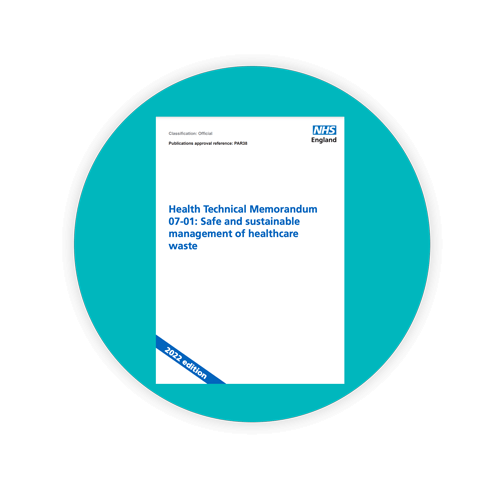NHS England Release 3 New Tools for More Sustainable Healthcare Waste Management

Are you aware that the NHS is one of the largest producers of waste in the UK?
Producing a colossal average of 156,000 tonnes of clinical waste each year that’s either sent to high-temperature incineration (HTI) or for alternative treatment (AT), NHS England has recognised that there’s an urgent need to introduce a more sustainable approach to healthcare waste management.
One of the biggest reasons for such high volumes being sent for carbon-intensive treatments is misclassification and incorrect segregation, largely due to a lack of education around proper waste management.
To improve general understanding and make things easier for all those working in healthcare, NHS England has released three helpful new tools:
1 / The NHS Clinical Waste Strategy
2 / An Updated Health Technical Memorandum (HTM)
3 / The Waste Carbon Reduction Tool
In this blog, we’ll take a brief look at each of these new tools and see how you can use them to benefit yourself and your facility, keeping you on track to achieve Net Zero by 2040.
The NHS Clinical Waste Strategy
On March 7th, 2023, NHS England unveiled its Clinical Waste Strategy outlining its vision for revamping its current processes by eliminating unnecessary waste, discovering fresh approaches for repurposing, and exploring innovative solutions for cost-effective, efficient, and sustainable processing.
This new Clinical Waste Strategy establishes an ambitious roadmap for transforming the handling of clinical waste, outlining targeted initiatives for NHS Estates teams:
- All NHS providers are to have Waste Managers who are fully trained to manage it correctly. They will support this with the first-ever NHS-certified Waste Management training course.
- Encouraging the 20-20-60 waste split* to improve segregation and reduce cost and environmental burden.
- Waste contract management is to be a priority for all NHS Trusts.
- The NHS will be empowered to own and manage its own processing assets and is exploring the use of innovative technologies to treat infectious waste on-site.
What Will the Clinical Waste Strategy Achieve?
The overtreatment of waste is avoidable when it’s correctly segregated. The majority can be diverted away from carbon-intensive treatments such as high-temperature incineration. Having trained experts in place to take an informed approach to waste management will lead to correct segregation and reduce overall waste volumes.
*The 20-20-60 waste split reduces the large volumes sent for high-temperature incineration (HTI) which is generated as a result of bad segregation practices and encourages a more sustainable and cost-effective solution to healthcare waste management.
The 20-20-60 split entails:
- 20% of waste sent for high-temperature incineration;
- 20% of waste sent for alternative treatment (AT);
- 60% of waste classified as offensive waste, which can be converted into energy.
An Updated Health Technical Memorandum (HTM) 07-01
The revised Health Technical Memorandum (HTM) 07-01: Safe and sustainable management of healthcare waste has been published to provide a best practice framework for the safe management of waste, ensuring it’s segregated correctly.
Created to replace the 2013 version of ‘Safe management of healthcare waste’, this new guidance has an increased focus on sustainability.
Released in line with the NHS Clinical Waste Strategy, this revision takes into account the developments in environmental legislation and regulation, as well as innovations in the field. It also incorporates circular economy concepts, environmental protection, enhanced social benefits, and the targets set out to achieve Net Zero. There’s also a focus on reducing carbon emissions from the production and processing of waste in support of the NHS’s goal of becoming a Net Zero healthcare system.
Some of the key changes include:
- A strategic approach with the goal of eliminating unnecessary waste, supporting efforts to prevent the incorrect classification and segregation of offensive waste as infectious waste.
- Added emphasis on advancing the circular economy and improving carbon performance, with the goal of encouraging practices that prioritise the implementation of the waste hierarchy and enhance resource efficiency.
- The necessary steps to reducing the use of single-use plastics in line with Government policy and commitment to Net Zero.
- The key principles of effective contract management including a standardised checklist of activities for monitoring contractors. It also addresses the approach to contingency planning in the event of contractor failure.
- A focused push to cultivate knowledge and skills within the in-house workforce to promote better decision-making within waste management.
- Refreshed technical guidance, best practice, and compliance requirements that reflect new and updated legislation, regulations and technical instruments.
- A defined process to better integrate opportunities within the system including innovation in waste management solutions.
- A more organised and optimised approach to sectoral guidance to eliminate repetition and redundancy.
How Does an Updated Health Technical Memorandum Help?
The purpose of this document is to provide a solid foundation of understanding for the improved management of healthcare waste; helping all those working in healthcare to play their part in creating a safer, more sustainable healthcare system.
As noted earlier, the previous edition of this guidance focused mainly on safety, whereas this revision gives sustainability the attention and focus it needs to achieve Net Zero.
The Waste Carbon Reduction Tool
The waste carbon reduction tool has been created to aid you in making informed, data-backed decisions, improve segregation and help reduce your carbon emissions. Moreover, this tool can be used to assess the cost and environmental impact of any decisions, allowing for outcomes to be quantified.
Saving Money, the Planet, and Each Other
Something that Greener NHS and the initiatives outlined for reaching Net Zero has made abundantly clear is that the safe and sustainable management of healthcare waste is everyone’s responsibility.
The Clinical Waste Strategy outlines an aim to reduce future volumes resulting in approximately £11 million in revenue savings every year for the next 10 years. It’s also expected to achieve a 30% reduction in carbon emissions and help the NHS reach Net Zero in its estate by 2040. Numbers and statistics are great, they’re also important for capturing accurate data; but what this all means on a human level is that by adopting this strategy you’ll be contributing to a safer and more sustainable healthcare system as well as protecting the environment, wildlife, and public health.
It’s recommended that you read the NHS Clinical Waste Strategy and the updated Health Technical Memorandum (HTM) 07-01 and apply what you learn to your daily practices. Tools and frameworks such as those outlined in this blog have been developed to help anyone involved in the healthcare industry to gain a better understanding of how to handle and manage waste in the best way. If you need guidance or have any questions about the waste in your facility, please feel free to reach out to one of our dedicated experts.
Let's Talk!
Your time is valuable, and we don’t want to play hard to get. You can either phone us directly on the details listed on our contact page, or feel free to fill out this short form and one of our team members will get back to you as quickly as possible.
